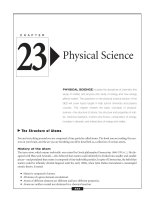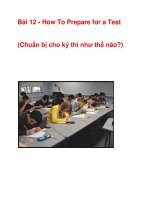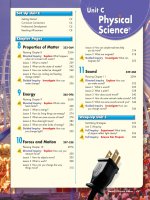3 12 how things move (physical science)
Bạn đang xem bản rút gọn của tài liệu. Xem và tải ngay bản đầy đủ của tài liệu tại đây (3.6 MB, 14 trang )
Genre
Nonfiction
Comprehension Skill
Summarize
Text Features
•
•
•
•
Captions
Call Outs
Labels
Glossary
Science Content
Forces and Motion
Scott Foresman Science 3.12
ISBN 0-328-13842-8
ì<(sk$m)=bdiecf< +^-Ä-U-Ä-U
Vocabulary
force
friction
gravity
magnetism
motion
position
relative position
speed
work
What did you learn?
1. What can you say about an object
that changes position?
2. If you were rowing a boat and
wanted to stop, what would you
do and why?
3. What is the measurement of how
fast or slow an object travels called?
4.
by Catherine
Quirin
In this book
you have read about forces. Write
to explain the difference between
a contact force and a non-contact
force. Include details from the book.
Picture Credits
Every effort has been made to secure permission and provide appropriate credit for photographic material.
The publisher deeply regrets any omission and pledges to correct errors called to its attention in subsequent editions.
Photo locators denoted as follows: Top (T), Center (C), Bottom (B), Left (L), Right (R), Background (Bkgd).
4 (C) Getty Images; 10 Paul Barton/Corbis; 14 Getty Images; 15 Getty Images; 16 (TL) Brenda Prince/Alamy Images.
Scott Foresman/Dorling Kindersley would also like to thank: 5 NASA/DK Images; 21 (CR) Stephen Oliver/DK Images.
Unless otherwise acknowledged, all photographs are the copyright © of Dorling Kindersley, a division of Pearson.
ISBN: 0-328-13842-8
Copyright © Pearson Education, Inc. All Rights Reserved. Printed in the United States of America.
This publication is protected by Copyright, and permission should be obtained from the publisher prior to any
prohibited reproduction, storage in a retrieval system, or transmission in any form by any means, electronic,
mechanical, photocopying, recording, or likewise. For information regarding permission(s), write to
Permissions Department, Scott Foresman, 1900 East Lake Avenue, Glenview, Illinois 60025.
3 4 5 6 7 8 9 10 V010 13 12 11 10 09 08 07 06 05
5.
Summarize Summarize why
simple machines are useful.
Understanding
Movement
Suppose a boy is doing homework
with his friend. His younger sister asks
if she can play. He tells her he needs
to study and she must sit still. His sister
jumps and dances. Then she moves across
the room to do a headstand!
2
The sister changes position when she moves
from one spot to another. She is in motion
when she changes position.
Her position changes compared to her
brother’s. First she is in front of him. Then
she is behind him. Both of these positions can
be called a relative position because it changes
when compared to her brother’s position.
3
Earth moves at
a constant speed.
How fast are these cars moving? Speed is
a measurement of how fast or slow something
changes position. The cars on the highway are
moving forward very quickly. Other things,
such as tortoises, move slowly.
4
Objects often change speeds, such as from
fast to slow. Other times, objects move at the
same speed. When an object moves at the same
speed, it moves at a constant speed. Earth is
something that moves at a constant speed.
How fast or slow an object moves is not the
only thing that can change. An object can also
change direction. It can move forward, backward,
sideways, or even in a circle. Sometimes an object
can move quickly going forward, but must slow
down to move backward or sideways. That object
would move at a variable speed. Its speed changes
as it moves in different directions.
5
Force
You make things move every day. You
probably pull open a drawer to get some socks
each morning. Then you push the drawer
closed. Any push or pull is called force. The
position of the drawer changed because you
used force.
Most of the forces that you use are contact
forces. This means that you touch, or make
contact with, the object you wish to move.
How much an object moves depends on how
much force you use. The greater the force placed
on an object, the more the object will move.
Could you
move a wall?
Sometimes you can use a lot of force to try
to move an object, but it does not move much
or at all. If you push against a wall, would you
be able to move it? Probably not, because the
amount of force you use is not enough to move
an object with as much mass as a wall. The greater
the mass of an object, the greater the force needed
to move it.
6
7
You can slide a desk across a classroom
that has a smooth tile floor. Could you
move the desk as easily if the floor were
covered with thick carpeting? Probably
not. The carpeting would rub against
the legs of the desk, making it harder
to move.
This rubbing is a contact force called
friction. If you want an object to move
quickly, friction can be a problem. If you
want to slow a moving object, such as a
rowboat, the friction caused by dragging
the oars in the water will help.
8
What happens if more than one force is used
on an object? Suppose you and your friend want
to use the same towel and are both equally strong.
If each of you grabs an end and pulls at the same
time using the same amount of force, what do you
think will happen? Neither one of you will be able
to pull the towel away from the other.
But what would happen if your older
brother had helped you? His force, combined
with yours, probably would have been greater
than your friend’s force. Your friend would
have lost because the towel would have
moved more easily toward the greater force
of your brother and you.
You must use some force
to keep your dog from
running away while
you are walking together.
9
Force and friction often work together to
start and stop motion. Suppose you are going to
in-line skate in the park. In order to start skating,
you need to push off the ground with one foot.
Then you must do the same with the other to
keep moving. The more force you use to push off
the ground, the faster your speed will be.
What happens if you need
to slow down and stop? To do
that you need to use friction.
If you press your heel down,
part of the skate will make
contact with the ground and
create friction. The friction made
by this contact slows your speed.
If you continue doing this,
you will be able to stop.
10
11
There are forces that can move or change
an object’s position without touching it.
These forces are called non-contact forces.
Gravity is a non-contact force that pulls
objects toward each other.
An object’s weight is a measurement of
how much pull gravity places on it. Your
weight is the amount of force that gravity
uses to pull you toward Earth’s center.
Weight depends on the mass of an object.
An object with more mass will be pulled
more strongly by gravity and will weigh more.
Magnet tower
You can feel the pull of gravity
when you cycle uphill.
Gravity is not the only non-contact force
at work. Have you ever played with magnets?
Do you remember how the magnets pulled
toward each other as you moved them close
together? This pulling is called magnetism.
Magnetism is a force that pulls on, or attracts,
metals that have iron in them. Magnets do not
attract objects such as wood or plastic because
they do not contain iron.
12
13
Think about trying to push a wall again.
Even if you pushed as hard as you could and
used great force, you would not move that wall.
Since work is done only when force makes
something move, no work would be done.
Is there another way to move that wall?
Maybe you are thinking that a machine could be
used to move the wall. You are right to think of
using a machine. A machine would be able
to push the wall with more force.
Did you know that playing is work?
Work
Did you know that you work every time you
cause something, including yourself, to move
or change position? Scientists think of work
as the use of force to move an object. Playing tag
is actually work, since you are moving your body.
The amount of work that is done depends on
how much force is used and how far the object
is moved.
14
15
Ramps are very useful
for wheelchair users.
Not all machines are big
and complicated. Simple
machines have few or no
moving parts. Inclined
planes, wedges, screws,
levers, wheels and axles,
and pulleys are all simple
machines.
How is an inclined plane
used? Suppose you need to
move a horse into a trailer.
A horse is very heavy,
so it would be very difficult
to carry. But an inclined
plane can help.
The word inclined means “leaning
or slanted.” A plane is a flat surface.
An inclined plane is a ramp.
A ramp makes it easier to move an
object from a higher position to a
lower one, or the reverse.
Walking a horse up a ramp, or
16
inclined plane, makes it possible to move it into
a trailer. The same amount of work, moving the
horse, would be done even if an inclined plane
were not used. But the inclined plane makes the
work a lot easier.
The ramp makes it easier
to move the horse into
the trailer.
Ramp
17
Another simple
machine that is often
used is a wedge. A
wedge has one or two
slanted sides that end in
a sharp edge. You can slide
a wedge of wood under a
door to hold it in place. You
can drive a wedge of metal
into a piece of wood to
split, or cut, it. The next
time your father uses
a knife to cut pieces of
cake, you can tell him
he is using a wedge!
A screw looks very different
from an inclined plane or a wedge.
It is actually an inclined plane that
is wrapped around a center post.
This makes ridges. A screw is used
to hold things together. Screws are
often used to hold furniture together.
If you open a jar, you are using
a screw. The inside of the lid has
thin ridges around its rim. These
ridges form a screw that helps you
to raise and lower the jar lid.
A screw
Screw ridges
Wedge
The lid of this
jar is a screw.
This axe is
a wedge.
18
19
A lever is a simple machine
that is used to lift and move things.
A lever is actually a stiff bar that
rests on something that supports it.
Are there seesaws in your school
playground? Seesaws are levers
that move two people up and down.
Have you ever seen a
garbage truck with big forklike
metal bars in front? Some
garbage bins are so big and
heavy that people cannot lift
them. The metal bars form a
lever that slips under the bin
and lifts it up to be emptied.
A seesaw is
a kind of lever
you can find
in some parks.
20
Handle
Fishing line
Reel with fishing line
Wheel
Axle
Inside of reel
A wheel and axle is a simple
machine. A wheel and axle is used on
a fishing rod. The handle of the fishing
rod acts as an axle that is attached to
the wheel, which contains the fishing
line. When the axle, or handle, turns,
it causes the wheel to turn. This makes
it easier to reel in the fishing line.
21
Another simple machine is called a pulley.
Have you ever watched someone raise and lower
a sail on a sailboat? If so, you have seen a pulley
at work. A pulley is made of a wheel that has
grooves, or ridges, on it and that turns on an axle.
The rope, with the sail attached to it, passes
through a pulley wheel that turns on a pin, or
axle. When someone pulls down on the rope, the
rope makes the wheel turn and the sail goes
up. Then the rope is tied in place. When
there is not much wind, someone unties
the rope. Then the pulley moves in the
opposite direction and the sail is lowered.
Things in motion and things at work
are all around us. The next time you ride
a bike, open a refrigerator, or bounce a
ball, think about how much you have
learned about motion and work!
This sailboat has
all its sails raised
to catch the wind.
A pulley is a simple machine.
Pulley
wheel
Rope
Load
22
23
Vocabulary
Glossary
force
friction
force
a push or pull
gravity
magnetism a contact force that opposes
friction
motion
the motion of an object
position
relative position
gravity
a non-contact force that pulls
speed
objects toward each other
work
magnetism
a non-contact force that attracts
metals containing iron
motion
a change of position
position
the location of an object
relative
position
Picture
Credits
the placement of an object
compared to another
Every effort has been made to secure permission and provide appropriate credit for photographic material.
The publisher deeply regrets any omission and pledges to correct errors called to its attention in subsequent editions.
rate at which, or how fast,
4 (C) Getty Images; 10 Paul Barton/Corbis; 14 Getty Images; 15 Getty Images; 16 (TL) Brenda Prince/Alamy Images.
an object changes its position
speed
Photo locators denoted as follows: Top (T), Center (C), Bottom (B), Left (L), Right (R), Background (Bkgd).
Scott Foresman/Dorling Kindersley would also like to thank: 5 NASA/DK Images; 21 (CR) Stephen Oliver/DK Images.
Unless otherwise acknowledged, all photographs are the copyright © of Dorling Kindersley, a division of Pearson.
work
the movement of an object
through the use of force
ISBN: 0-328-13842-8
Copyright © Pearson Education, Inc. All Rights Reserved. Printed in the United States of America.
This publication is protected by Copyright, and permission should be obtained from the publisher prior to any
prohibited reproduction, storage in a retrieval system, or transmission in any form by any means, electronic,
mechanical, photocopying, recording, or likewise. For information regarding permission(s), write to
Permissions Department, Scott Foresman, 1900 East Lake Avenue, Glenview, Illinois 60025.
24
3 4 5 6 7 8 9 10 V010 13 12 11 10 09 08 07 06 05
What did you learn?
1. What can you say about an object
that changes position?
2. If you were rowing a boat and
wanted to stop, what would you
do and why?
3. What is the measurement of how
fast or slow an object travels called?
4.
In this book
you have read about forces. Write
to explain the difference between
a contact force and a non-contact
force. Include details from the book.
5.
Summarize Summarize why
simple machines are useful.









